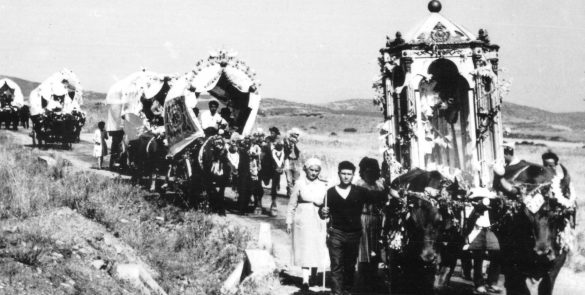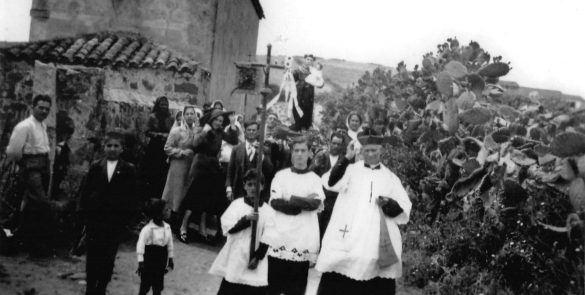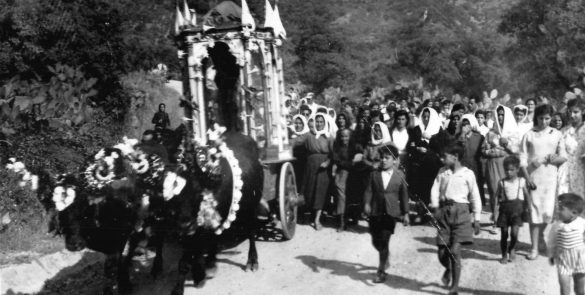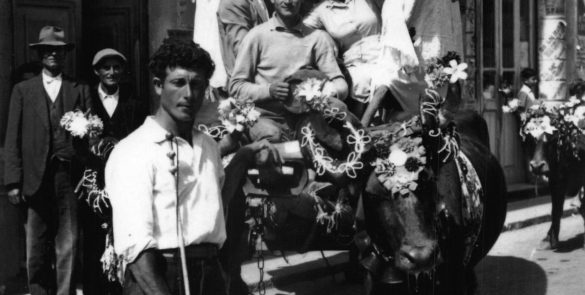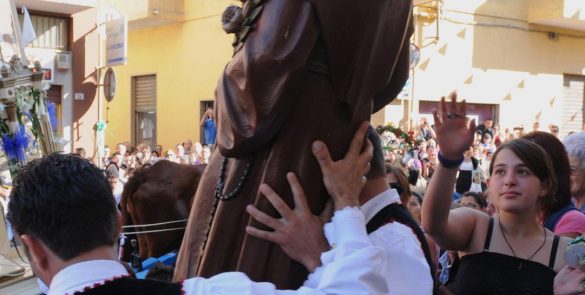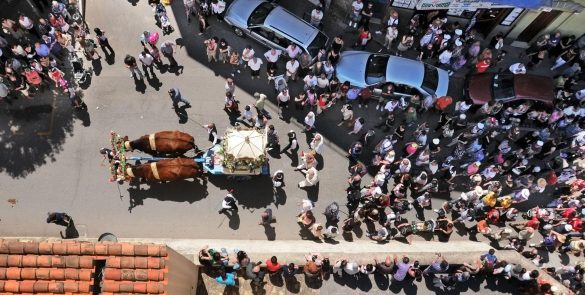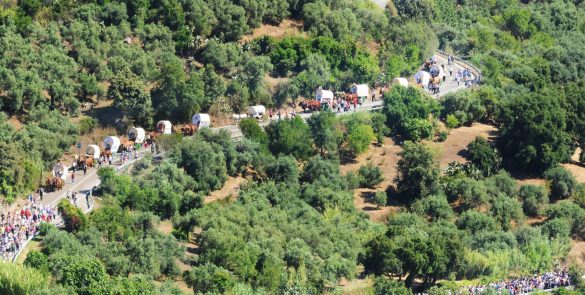ARBUS
In Arbus, in the month of June, the Feast of St Anthony of Padua has been held for over 400 years, one of the most important religious processions in Sardinia. The pilgrimage starts from the church of San Sebastiano di Arbus and ends after about 38 km in the hamlet of Sant’Antonio di Santadi. It seems that Santadi was founded in the imperial period around the farm of a rich landowner from nearby Neapolis. Initially it was inhabited by slaves engaged only in agriculture; during the barbarian invasions the village was first depopulated and then repopulated at the end of the fighting. Those who fled took refuge mainly in Arbus, returning to the town only for sowing or harvesting, and those who escaped from the barbarians used to take with them the statue and simulacrum of their protector St. Anthony of Padua for fear that it would be desecrated by the invaders, in fact it is thought that for this reason was born the “pilgrimage” that starts from the church of San Sebastiano in Arbus to the church of Sant’Antonio in Santadi on the first Saturday after the 13th of June each year.
The legend concerning the origin of the festival in Arbus tells that once upon a time, where the Church of Santadi is located today, there was a house that fell into ruin after the death of its owner, and that when the statue of Saint Anthony was found on the rocks of the nearby beaches, the inhabitants decided to build a chapel and venerate the saint whose statue had been found along the coast.
Numerous believers follow this rite on foot and in the traditional floats – sas traccas, festively decorated as they were hundreds of years ago. On the Saturday of the start of the procession, the ox-cart arrives at the church of S. Sebastiano to welcome the simulacrum of St Anthony. The solemn procession is accompanied by folk groups, horsemen, launeddas players, the musical band, the parish priest, other religious figures, oxen carts and motorised carts festively harnessed. Leaving the town of Arbus, the procession crosses the nearby centre of Guspini and continues towards the hamlet of Sant’Antonio di Santadi, where it arrives at around 11pm. The celebrations continue on Sunday and Monday in the small village of Sant’Antonio di Santadi, 3 km from Pistis beach. On Tuesday, at the first light of dawn, the Saint is put back in the coach to return to Arbus. The festival is organised not only with the support of the municipal administration, but also by the Pro Loco di Arbus and the Comitato ‘Passu Passu cun tui Antoni Santu’. The feast in honour of the saint ends with the traditional fireworks, with the wish to renew it: “Atrus annus”.

VIDEO
IMAGE GALLERY




ARBUS
In Arbus, in the month of June, the Feast of St Anthony of Padua has been held for over 400 years, one of the most important religious processions in Sardinia. The pilgrimage starts from the church of San Sebastiano di Arbus and ends after about 38 km in the hamlet of Sant’Antonio di Santadi. It seems that Santadi was founded in the imperial period around the farm of a rich landowner from nearby Neapolis. Initially it was inhabited by slaves engaged only in agriculture; during the barbarian invasions the village was first depopulated and then repopulated at the end of the fighting. Those who fled took refuge mainly in Arbus, returning to the town only for sowing or harvesting, and those who escaped from the barbarians used to take with them the statue and simulacrum of their protector St. Anthony of Padua for fear that it would be desecrated by the invaders, in fact it is thought that for this reason was born the “pilgrimage” that starts from the church of San Sebastiano in Arbus to the church of Sant’Antonio in Santadi on the first Saturday after the 13th of June each year.
The legend concerning the origin of the festival in Arbus tells that once upon a time, where the Church of Santadi is located today, there was a house that fell into ruin after the death of its owner, and that when the statue of Saint Anthony was found on the rocks of the nearby beaches, the inhabitants decided to build a chapel and venerate the saint whose statue had been found along the coast.
Numerous believers follow this rite on foot and in the traditional floats – sas traccas, festively decorated as they were hundreds of years ago. On the Saturday of the start of the procession, the ox-cart arrives at the church of S. Sebastiano to welcome the simulacrum of St Anthony. The solemn procession is accompanied by folk groups, horsemen, launeddas players, the musical band, the parish priest, other religious figures, oxen carts and motorised carts festively harnessed. Leaving the town of Arbus, the procession crosses the nearby centre of Guspini and continues towards the hamlet of Sant’Antonio di Santadi, where it arrives at around 11pm. The celebrations continue on Sunday and Monday in the small village of Sant’Antonio di Santadi, 3 km from Pistis beach. On Tuesday, at the first light of dawn, the Saint is put back in the coach to return to Arbus. The festival is organised not only with the support of the municipal administration, but also by the Pro Loco di Arbus and the Comitato ‘Passu Passu cun tui Antoni Santu’. The feast in honour of the saint ends with the traditional fireworks, with the wish to renew it: “Atrus annus”.
VIDEO
